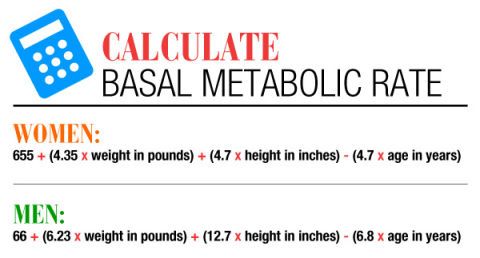
It is measured by the oxygen uptake under strict conditions, namely: no food consumed and no undue muscle exertion in the 12 hours preceding the measurement the measurement is taken after 30-60 min of resting or lying quietly in a temperature neutral environment. The basal metabolic rate (BMR) is the minimum energy requirement to stay alive and awake. the energy expended during physical activity and post-activity recovery (physical work, sports training, etc.), a.k.a.the thermogenic influence of any food consumed during the day (DIT).the resting metabolic rate (includes basal and sleeping conditions and the cost of staying awake), RMR.To determine the daily EER one needs to estimate or know: Although there are general guidelines, it is always recommended to consult your doctor on the recommended increase in food intake during pregnancy.

Older individuals expend less energy than younger ones of the same weight and gender as you will note if you enter a different age in our online estimated energy requirement calculator.įor women pregnancy is also a factor due to the related increase in the energy cost of all physical activities. Age is also a factor our tool takes into account. As women tend to have a higher percentage of body fat and smaller muscle mass, this results in lower energy expenditure relative to their weight than a similarly weighted male. Hot climate can increase your EER by 5-20%, but cold climate can have similar effects due to shivering and increased metabolism to maintain core temperature so it is a factor not generally taken into account.īody size and composition play a role in EER and one can tell this by the output of our EER calculator for the two genders. The exact value depends on the macro mix and it can go as low as 6 or 7 percent with a strict Keto diet which is, however, very hard to maintain in the long run.Ĭlimate is a factor over which one has limited control. The thermic effect of food is part of total energy expenditure and it's range is between 10-13% of the energy provided by the food.

Increased physical activity can greatly increase the need for nutritional food, and likewise a decrease in activity would come with a decreased energy requirement.Ī person's diet is also important in terms of the macronutrient composition of the food one eats. The level of physical activity (PAL) has the largest effect of these three - between 15 and 30% of total EER and it is also the factor that can be affected the most (to a limit). There are three main things that affect your daily EER: physical activity, dietary-induced thermogenesis (DIT), and the climate you spend most of your time in. It is the same concept as the one denoted by TDEE (Total Daily Energy Expenditure).


 0 kommentar(er)
0 kommentar(er)
